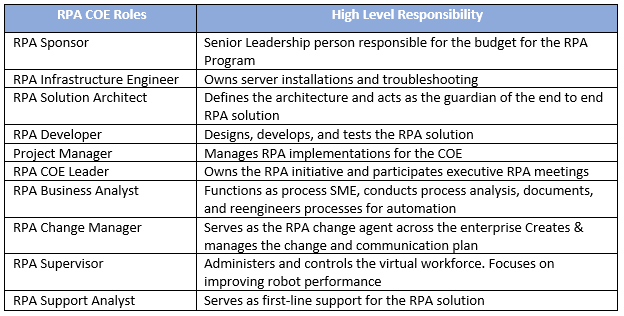
This article will focus on the importance of the RPA Team Structure. This will ensure your internal RPA COE team adhere to Automation Best Practise principles right across the JifJaff Nine Pillars.
Every RPA implementation team must have a deep understanding of the processes for automation and the skills required to develop an automation program. A lack of adequately trained or appropriately skilled automation specialists can risk the success of an RPA implementation project and minimise opportunities for achieving maximum benefits.
Varying degrees of responsibility will be delegated to process subject matter experts, process analysts, solution architects, developers, as well as IT security and infrastructure specialists. This kind of structure and organisation within the team will help define the accountabilities of the involved individuals and enable the adequate flow of communication.
Articulating an effective governance model is highly important. Governance takes responsibility for assessing RPA opportunities and prioritising automation activities. It provides the guidelines and templates for assessment, design, development, and deployment of robots, managing the demand pipeline. It involves assigning roles & accountability and ensures good collaboration and communication between units. Within the governance process, change management issues & risks are laid out and frameworks & templates for change management are established.
Performance and productivity metrics & measurement are also circulated via the governance process in order to carry out impact assessments and highlight areas for business improvement. While RPA is usually business-driven, getting IT onboard is essential to integrating the technology into the project and managing dependencies. This is why governance actually sits somewhere between Business and IT.
The COE team is a cross-functional team with skills ranging from Strategy, Process Re-engineering, IT Infrastructure and Development, Change Management and Customer Support – Key roles:

Team selection plays a very important part and can make or break your transformation agenda. Choosing the right team members, fitting in with your organisation structure goes a long way in making enterprise RPA programs successful. Your “RPA team” are your “transformation evangelists” – the change agents who drive the transformation agenda. Training becomes a core pillar.
Team selection plays a very important part and can make or break your transformation agenda. Choosing the right team members, fitting in with your organisation structure goes a long way in making enterprise RPA programs successful. Your “RPA team” are your “transformation evangelists” – the change agents who drive the transformation agenda. Training becomes a core pillar.
Below are the top 5 key considerations to optimise RPA Team structure:
Set up an RPA team with well-defined roles and responsibilities. Identify an RPA sponsor, change manager, solution architects, developers, infrastructure, and service support to take on key roles in the RPA COE. The team needs to understand how to work well together – and with stakeholders – to deploy automation technology, adhere to standard processes and procedures, and measure business metrics and performance goals, including return on investment and customer satisfaction.
Establish an RPA Steering Committee. The Steering committee provides overall governance and direction. It should meet regularly and include key representatives from the Business, IT, Finance, Audit and RPA COE team who will ensure the outcomes of RPA initiatives are in line with the objectives and expectations of executive management. The committee should focus on driving RPA adoption across business units to create economies of scale and thereby maximise their investment and Bot utilisation.
Establish an effective Governance model. As RPA deployment expands across an enterprise, the RPA COE likely will face challenges related to cross-departmental collaboration. This requires a governance framework that determines participation and interaction among different departments and establishes protocols and prioritisation for managing and sharing knowledge. The governance structure should create a framework for developing and applying best practices to each stage of an RPA implementation.
Effective Change Management. Change management is a key function of the RPA COE team. To maximise value from digital transformation, organisations need to proactively plan how they will manage the changes that result from automation. Many companies cite a lack of effective change management as another significant reason for failing in automation implementation.
Collaboration with IT: The IT team is directly involved in any RPA project implemented within the organisation, so it is crucial to coordinate your actions with them from the very beginning. The RPA COE should collaborate with the team on infrastructure change, security, compliance, and other IT functions. Some COEs create a special IT liaison position that works directly with the IT team to coordinate RPA rollouts.

